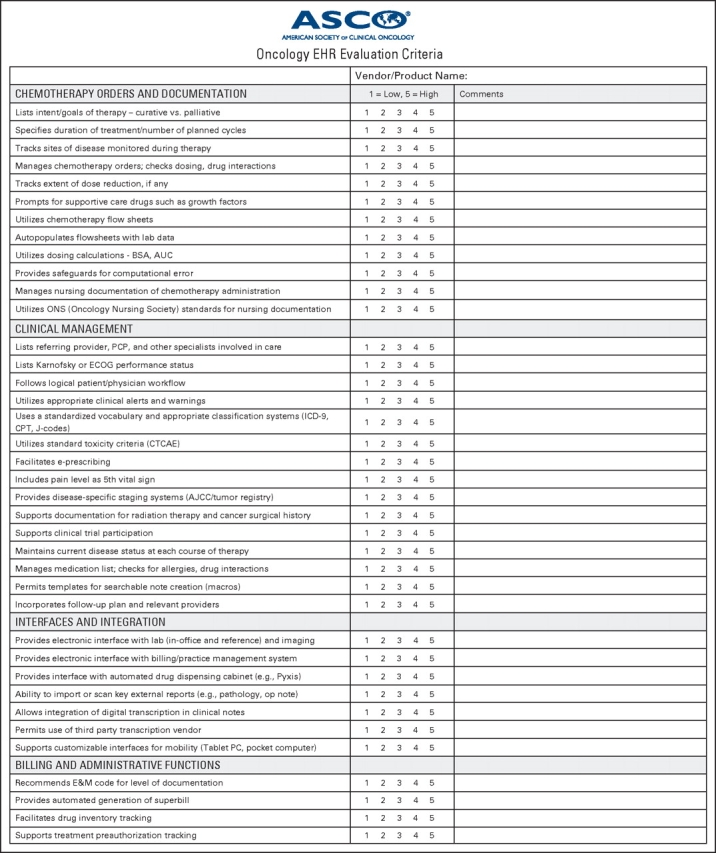The American Society of Clinical Oncology (ASCO) has been active in 2007 in providing education and resources for physicians as they consider electronic health record (EHR) systems. Selecting an EHR is a major operational and financial decision for oncologists and there is not one perfect system for all practices. These frequently asked questions provide guidance for the selection process.
How should I start the process of selecting an EHR for my practice?
An important first step is to determine your practice goals for implementing an EHR. Having specific practice goals will help focus your search. Goals generally fall into three categories: clinical, operational, and financial. Examples of clinical goals include improving the chemotherapy ordering process or standardizing treatment regimens in a group practice. Many practices focus on operational goals such as improving access to patient records both in the clinic as well as from outside the clinic, or improving evaluation and management coding documentation. Some practices focus on financial goals such as decreasing overhead associated with chart pulls and supply costs or decreasing medical transcription costs. Many practices begin to consider an EHR to meet payer requirements, especially those related to pay for reporting or pay-for-performance programs.After you have determined your practice goals for an EHR, develop a specific list of needs for your practice. Start with a list of technology currently in use in your practice, such as your practice management system, laboratory information system, and inventory control system. Identify the systems that will require interfaces with your EHR. Next, consider the physical location of your EHR. Which staff members will use it and where will they use it? Do you want to have computers in every examination room or will the staff use portable devices?Information technology consultants recommend that practices include a workflow redesign as part of the transition to an EHR. Identify the critical functions for a computerized system in your practice and consider the impact on your current processes. Determine whether you will use internal resources for workflow redesign, whether you will engage a consultant, or whether this is a service you want your EHR vendor to provide.At the completion of this planning process, develop a list of criteria for your practice to use to evaluate EHR systems and use this list to identify the systems that your practice should consider.The ASCO EHR Workgroup has developed a list of core functions for an oncology EHR and an Oncology EHR Criteria Evaluation tool based on this core list. This list of core functions is available at www.asco.org/ehr. The Oncology EHR Criteria Evaluation Tool is included as Figure 1.
Figure 1.

Oncology Electronic Health Record Criteria Evaluation Tool
Figure 1.
(Continued)
How do I find the right system for my practice?
After you've completed the planning processes already discussed, you are ready to start looking at systems. There are many EHR systems available today. First, determine whether you are looking for a general EHR or an oncology-specific system and then whether you need medical oncology, radiation oncology, or both. Next, ask the vendor about the practice size they generally support to find a good match for your practice. Identify several vendors that meet these broad requirements then begin a more thorough examination of each vendor. A list of suggested questions as you begin the due diligence process is included.Ask the vendor to provide names of other oncology practices that use their system. Contact each of these practices and ask about their experience with both the system and the vendor. Schedule site visits to see systems you are most interested in actually at work in a practice. These site visits are essential and should ideally be scheduled during a work day when you can see the system actually working and ask questions of the physicians and staff. Ask about their experience with installation and training, as well as impact on workflow.
How do I know if my staff is ready for an EHR?
It is important to assess staff readiness before making an EHR purchase. Don't assume everyone on your staff is comfortable with computers. Develop a plan to identify and train staff members on computer skills necessary for the successful use of an EHR.Identifying staff members for this training starts with a simple questionnaire. Questions might include: Do you have a computer at home? Do you use it more than three times per week? Have you ever had any formal computer training? How would you rate yourself as a computer user in general? You may also want to include questions about specific software programs or use of the Internet.Once you have identified staff members that need computer training, find appropriate training opportunities. Resources include local seminars, continuing education courses in the community, and online training programs.
Due Diligence – Questions to Ask.
How long has the vendor been in business?
Is the company public or private? Are they financially stable?
What is the vendor planning for new releases? Is there a cost for new releases?
What is their vision for your product for the future? How long do they expect to support the product you are purchasing?
Do they have interfaces already written for your other systems? What is the cost for each interface?
How many oncology practices have successfully installed this system? Will the vendor provide references?



